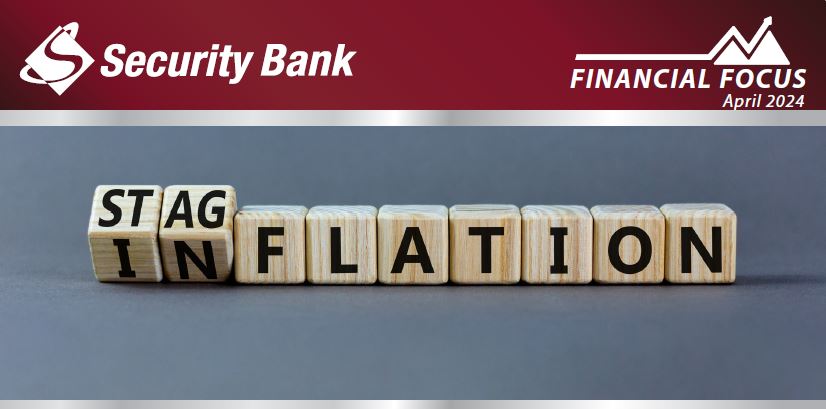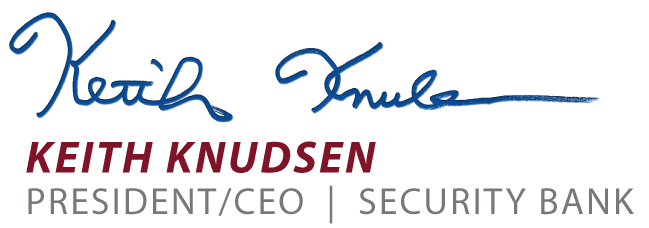
Navigating Stagflation
April 30, 2024
| AgFocus-Ag Focus | BusinessFocus-Business Focus | BankingFocus-Banking Focus | BankingFocus-Financial Tips
|
 The spring season is upon us! The moisture in recent weeks may delay progress in the fields but is more than welcomed by all. As we prepare for what lies ahead, including the possibility of stagflation, let’s explore ways to turn uncertain times into an opportunity for your small business to thrive. The spring season is upon us! The moisture in recent weeks may delay progress in the fields but is more than welcomed by all. As we prepare for what lies ahead, including the possibility of stagflation, let’s explore ways to turn uncertain times into an opportunity for your small business to thrive.

|
How Small Businesses Pull Ahead Through Tough Times
“Nobody is really prepared for stagflation” says Fed Chair Jerome Powell in March of this year. Prepared or not, our economy is suspected to be heading towards stagflation. Stagflation is a term that describes a rare and challenging economic situation characterized by stagnant economic growth, high unemployment which fortunately doesn’t seem to be affecting our communities, and inflation above the target set by the Fed.
It's a dilemma for policymakers and economists alike because the typical tools used to combat inflation, like raising interest rates, can further slow economic growth and exacerbate unemployment. In such times, small businesses face unique challenges but also opportunities to innovate and adapt. Let's explore deeper into what stagflation entails and how small businesses can navigate through it.
Understanding Stagflation:
- Stagnant Economic Growth: Stagflation occurs when an economy experiences little to no growth in its gross domestic product (GDP). This stagnant growth can result from various factors, such as a decrease in consumer spending, declining business investment, or external shocks like a sudden rise in energy prices.
- High Unemployment: Despite the lack of economic growth, unemployment rates remain stubbornly high. This could be due to businesses scaling back operations or implementing cost-cutting measures to offset rising expenses, leading to layoffs and job losses. Fortunately, for our communities, this does not seem to be affecting us directly.
- Inflation Above Target: One of the defining features of stagflation is the presence of high inflation alongside economic stagnation. Inflation erodes purchasing power, making goods and services more expensive for consumers and adding pressure to business costs, particularly for raw materials and labor.
Strategies for Small Businesses:
- Cost Management: Inflation often leads to increased costs for businesses, but small businesses can mitigate this impact by focusing on cost management strategies. This might include renegotiating contracts with suppliers, optimizing inventory levels to reduce carrying costs, and implementing energy-efficient measures to lower utility expenses.
- Diversification: Diversifying product offerings or target markets can help small businesses weather the storm of stagflation. By expanding into new markets or offering complementary services, businesses can offset declines in demand in one area with growth in another.
- Innovation and Efficiency: Stagflation necessitates a focus on efficiency and innovation to maintain competitiveness. Small businesses can leverage technology to streamline operations, automate repetitive tasks, and improve productivity. Additionally, innovating with new products or services that cater to changing consumer needs can create new revenue streams.
- Customer Relationships: Building strong relationships with customers becomes even more critical during times of economic uncertainty. Small businesses can differentiate themselves by providing exceptional customer service, personalized experiences, and flexible payment options to retain existing customers and attract new ones.
- Agility and Adaptability: Stagflation requires small businesses to be agile and adaptable in responding to changing market conditions. This might involve adjusting pricing strategies, revising marketing campaigns, or reallocating resources to capitalize on emerging opportunities.
While stagflation presents significant challenges for small businesses, it also offers opportunities for innovation, resilience, and growth. By adopting proactive strategies focused on cost management, diversification, innovation, customer relationships, and agility, small businesses can not only survive but thrive in challenging economic environments. Ultimately, it's the ability to adapt and evolve that distinguishes successful businesses during times of uncertainty.